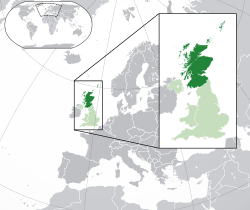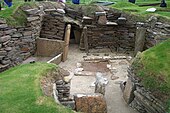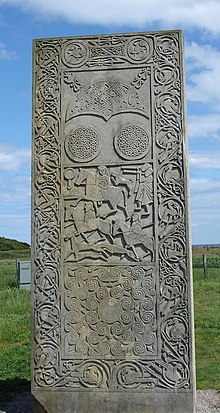Scotland
- For mair airticles adae wi fowk, steids an things in Scotland tak a keek at category:Scotland.
Scotland Scots Gaelic: Alba | |
|---|---|
Motto: "In My Defens God Me Defend"a | |
 Location o Scotland (dark green) – on the European continent (green & dark grey) | |
| Status | Kintra |
| Caipital | Edinburgh |
| Lairgest ceety | Glesga 55°51′N 4°16′W / 55.850°N 4.267°W |
| Offeecial leids[5] | |
| Releegion | |
| Demonym(s) | Scots |
| Govrenment | Devolved pairlamentary legislatur within constitutional monarchye |
• Monarch | |
| Pairlament o the Unitit Kinrick | |
| Keir Starmer | |
| Ian Murray | |
| 59 MPs (o 650) | |
| Legislatur | Scots Pairlament |
| Formation | |
| 9t yearhunder (tradeetionally 843) | |
| 1 Mey 1707 | |
| 19 November 1998 | |
| Aurie | |
• Land | 77,933 km2 (30,090 sq mi)[8] |
| Population | |
• 2019 estimate | |
• 2011 census | 5,313,600[10] |
• Density | 67.5/km2 (174.8/sq mi) |
| HDI (2017) | 0.901[11] verra heich |
| Currency | Poond sterling (GBP) |
| Time zone | UTC (GMT) |
• Summer (DST) | UTC+1 (BST) |
| Date format | dd/mm/yyyy (AD) |
| Drivin side | caur |
| Cawin code | +44 |
| ISO 3166 code | GB-SCT |
Wabsteid www | |
| |
Scotland (pronooncit [ˈskɔʔlənd]; Inglis: Scotland; Scots Gaelic: Alba, [ˈal̪ˠapə] (![]() listen)) is a kintra in north wastren Europe, an is wan o the fower kintras[15] that maks the Unitit Kinrick. It taks up the northren thurd o the Great Breetain. Sooth o Scotland is Ingland, an is bund bi the German Ocean til the east an the Atlantic Ocean til the north an wast.
listen)) is a kintra in north wastren Europe, an is wan o the fower kintras[15] that maks the Unitit Kinrick. It taks up the northren thurd o the Great Breetain. Sooth o Scotland is Ingland, an is bund bi the German Ocean til the east an the Atlantic Ocean til the north an wast.
Scotland wis ance a free kinrick, but syne gaed intil a union wi England in 1603, whan Jeams VI o Scotland becam Jeams I o England efter the deith o Elspeth I. This union wis makkit formal on 1 Mey 1707 bi the Treaty o Union. The Scots Pairlament wis gotten rid o on 26 Mairch. The union southert baith kinricks, makkin the Kinrick o Great Breetain, wi a new single Pairlament haudden in Wastmeenster, Lunnon, but some pairts o Scotland's institutions, merkit the laund's naitional kirk an scuilin an legal systems, wis hauden apairt. In 1801, Scotland becam ane o the three launds o the Unitit Kinrick, alang wi England an Ireland (nou juist Northren Ireland). Wales is nou seen for uisual as anither laund, awtho it wis juist a principality o the kinrick o England in 1707.
In 1997, the Scots fowk voted tae hae a new pairlament, estaiblisht by the UK government in the Scotland Act 1998. The nou reconvened Scots Pairlament haes been gien the pouer tae govern the laund on maist Scots maiters, but haesna ower muckle pouer wi taxes, awtho it dis hae the pouer tae chynge the UK income tax rate bi 3p in the pund.
Scotland's size is maistly that estaiblisht by the 1237 Treaty o York atween Scotland an England an the 1266 Treaty o Perth atween Scotland an Norawa. Exceptions is the Isle o Mann, that is nou a croun dependency ootwi the Unitit Kinrick, Orkney an Shetland, that is nou Scots raither nor Dens, an Berwick, that wis defined as subject til the laws o England by the 1746 Wales an Berwick Act.
The patron saunt o Scotland is Saunt Andra, an St Andra's Day is on 30 November but it haesna been celebrate muckle syne the Reformation.
The wird Scot wis taen frae the Laitin an its uiss micht weel date fae aboot the first hauf o the 10t centurie, whan it first kythed in the Anglo-Saxon Chronicle an harkent til the Laund o the Gaels, analogous til the Laitin Scotia. The ither name is "Caledonie", that's gien tae some pairts o the New Warld an colonies, like New Caledon. Scots kings adoptit the teetle Basileus/Rex Scottorum (= Hie King/King o the Gaels, basileus meanin sovereign in the Greek, an rex meanin king in the Laitin) an Rex Scotiae (King o Gael-Land) sometime in the 11t century, likely swee'd by the style Imperator Scottorum kent tae hae been uised bi Brian Bóruma in Ireland in 1005. In modren times the wird "Scot" is uised equaly for aw indwallers nae maiter wha thair forebeirs wis. This is acause the kintra haess haed a ceevic raither nor a single kin orientation for maist o the last thoosand year.
History
[eedit | eedit soorce]
Early history
[eedit | eedit soorce]Repeated glaciations, that kivered the hale laund-mass o modren Scotland, hae malafoustered ony traces that micht hae existit o bodies bidin thare afore the Mesolithic period. It is thocht that the first post-glacial groups o hunter-gaitherers wan til Scotland aboot 12,800 year syne, as the ice sheet retreated efter the last glaciation.[16][17] Groups o sattlers begoud biggin the first kent permanent hooses on Scots syle aroond 9,500 year aby, an the first clachans around 6,000 year syne. The weel-presered clachan o Skara Brae on the Mainlaund o Orkney dates frae this period. Neolithic habitation, buirial an reetual steids is in parteecular common an weel-presered in the Northren Isles an Wastren Isles, whaur want o trees led tae maist structurs bein biggit wi local stane.[18]
Roman influence
[eedit | eedit soorce]

The written protohistory o Scotland begoud wi the in comin o the Roman Empire in soothren an central Great Breetain, whan the Romans occupied whit is nou Ingland an Wales, administerin it as a province cried Britannia. Roman invasions an occupations o soothren Scotland war a series o brief interludes. In 83–4 AD the general Gnaeus Julius Agricola defeated the Caledonians at the battle o Mons Graupius, an Roman forts war briefly set alang the Gask Ridge naur tae the Hieland line (nane are kent tae hae been constructed ayont that line). Three year efter the battle the Roman airmies haed resiled tae the Soothren Uplands.[19] Thay pit up Hadrian's Waw for tae haud in the tribes on baith sides o the waw,[20] an the Limes Britannicus becam the northren laundmairch o the empire, awtho the airmy hauden on tae the Antonine Waw in the Central Lawlands for twa short periods—the hindmaist o thaim wis durin the time o Emperor Septimius Severus frae 208 till 210.[21] The extent o Roman military occupation o ony significant pairt o Scotland wis limited tae a total o aboot 40 year, awtho thair influence on the soothren section o the kintra occupeed by Brythonic tribes sic as the Votadini an Damnonii wad still hae been considerable.[20]
Medieval period
[eedit | eedit soorce]Modern history
[eedit | eedit soorce]
In 1603, James VI, King o Scots inherited the throne o the Kinrick o Ingland, an becam King James I o Ingland, an left Edinburgh for Lunnon.[22] Apairt frae a short period unner the Protectorate, Scotland steyed a sinder state, but there wis guid puckle conflict atween the croun an the Covenanters ower the form o kirk government. Efter the Glorious Revolution, the abolition o episcopacy an the dingin doun o the Roman Catholic James VII by William an Mary, Scotland briefly shored tae wale a different Protestant monarch frae Ingland.[23] In 1707, the Scots Pairlament an the Pairlament o Ingland enacted the twin Acts o Union that led tae Scotland's formal incorporation intae the Kinrick o Great Breetain.[24] The deponed Jacobite Stuart claimants haed steyed popular in the Hielands an nor'east, in parteecular amangst non-Presbyterians. Houaniver, twa major Jacobite uprisings launched in 1715 an 1745 failt tae remuive the Hoose o Hanover frae the British throne. The threit o the Jacobite muivement tae the Unitit Kinrick an its monarchs effective endit at the Battle o Culloden, Great Breetain's last pitched battle. This defeat paved the wey for lairge-scale remuivals o the indwallers o the Hielands an Islands, kent as the Hieland Clearances.[24]
The Scots Enlightenment an the Industrial Revolution makkit Scotland intae an intellectual, commercial an industrial pouerhoose. Efter Seicont Warld Weir, Scotland experienced an industrial decline that wis parteecular severe.[25] Anerly in raicent decades haes the kintra enjoyed something o a cultural an economic renaissance. Economic factors that hae contribute tae this recovery include a resurgent financial services industry, electronics manufacturin, (see Silicon Glen),[26] an the German Ocean ile an gas industry.[27]
Follaein a referendum on devolution proposals in 1997, the Scotland Act 1998 [28] wis passed by the Unitit Kinrick Pairlament for tae estaiblish a devolved Scots Pairlament.
Ilands
[eedit | eedit soorce]Scotland haes mair nor 790 ilands, that ar sindert intil fower groups: Shetland, Orkney, an the Hebrides, that ar sub-dividit intil the Inner Hebrides an Ooter Hebrides, the ail o Mull isnae ti be forgotten.
References
[eedit | eedit soorce]- ↑ "St Andrew—Quick Facts". Scotland. org—The Official Online Gateway. Archived frae the original on 11 November 2007. Retrieved 2 December 2007.
- ↑ "St Andrew". Catholic Online. Retrieved 15 November 2011.
- ↑ "St Margaret of Scotland". Catholic Online. Retrieved 15 November 2011.
"Patron saints". Catholic Online. Retrieved 15 November 2011. - ↑ "St Columba". Catholic Online. Retrieved 15 November 2011.
- ↑ "FACT: SCOTLAND'S OFFICIAL LANGUAGES ARE ENGLISH, SCOTS, GAELIC & BRITISH SIGN LANGUAGE". Scotland.org. Retrieved 27 Mairch 2023.
- ↑ "Analysis of Religion in the 2001 Census". The Scottish Government. 17 Mey 2006. Archived frae the original on 6 Juin 2011. Retrieved 18 Juin 2017.
- ↑ "Scotland's Census 2011 – Table KS209SCb" (PDF). scotlandscensus.gov.uk. Retrieved 26 Mairch 2017.
- ↑ Region and Country Profiles, Key Statistics and Profiles, October 2013, ONS. Retrieved 9 August 2015.
- ↑ Jonathan, McMullan (28 Juin 2018). "Population estimates for UK, England and Wales, Scotland and Northern Ireland". Ons.gov.uk (in Inglis). Office for National Statistics.
- ↑ "Population estimates by sex, age and administrative area, Scotland, 2011 and 2012". National Records of Scotland. 8 August 2013. Retrieved 8 August 2013.
- ↑ "Sub-national HDI – Area Database – Global Data Lab". hdi.globaldatalab.org (in Inglis). Retrieved 13 September 2018.
- ↑ "European Charter for Regional or Minority Languages". Cooncil o Europe (in Inglis). Retrieved 10 December 2019.
- ↑ Macleod, Angus "Gaelic given official status" Archived 2010-05-31 at the Wayback Machine (22 April 2005) The Times. London. Retrieved 2 August 2007.
- ↑ "Scotland becomes first part of UK to recognise signing for deaf as official language". Herald Scotland. 2015. Retrieved 17 Januar 2016.
- ↑ Scotland, Ingland, Wales an Northren Ireland
- ↑ The earliest kent evidence is a keezle-stane arraeheid frae Islay. See Moffat, Alistair (2005). Before Scotland: The Story of Scotland Before History. London: Thames & Hudson. pp. Page 42.
- ↑ Sites at Cramond dated tae 8500 BC an naur Kinloch, Rùm frae 7700 BC provide the earliest kent evidence o bodies bidin in Scotland. See "The Megalithic Portal and Megalith Map: Rubbish dump reveals time-capsule of Scotland's earliest settlements". megalithic.co.uk. Retrieved 10 Februar 2008. and Edwards, Kevin J. and Whittington, Graeme "Vegetation Change" in Edwards, Kevin J. & Ralston, Ian B.M. (Eds) (2003). Scotland After the Ice Age: Environment, Archaeology and History, 8000 BC–AD 1000. Edinburgh: Edinburgh University Press. pp. Page 70.CS1 maint: multiple names: authors leet (link) CS1 maint: extra text: authors leet (link)
- ↑ Pryor, Francis (2003). Britain BC. London: HarperPerennial. pp. pp. 98–104 & 246–250. ISBN 978-0007126934.CS1 maint: extra text (link)
- ↑ Hanson, William S. The Roman Presence: Brief Interludes, in Edwards, Kevin J. & Ralston, Ian B.M. (Eds) (2003). Scotland After the Ice Age: Environment, Archeology and History, 8000 BC - AD 1000. Edinburgh: Edinburgh University Press.CS1 maint: multiple names: authors leet (link) CS1 maint: extra text: authors leet (link)
- ↑ a b Snyder, Christopher A. (2003). The Britons. Blackwell Publishing. ISBN 0-631-22260-X.
- ↑ Robertson, Anne S. (1960). The Antonine Wall. Glasgow Archaeological Society.
- ↑ Ross, David (2002). Chronology of Scottish History. Geddes & Grosset. p. 56. ISBN 1-85534-380-0.
1603: James VI becomes James I o Ingland in the Union o the Crouns, an quats Edinburgh for Lunnon
- ↑ TM Devine (1999) op cit "…Stated that the Scots Parliament had the right to decide on Queen Anne's successor, and that England and Scotland could not have the same sovereign in the future unless the London Parliament granted Scots 'Free Communication of trade'…"
- ↑ a b Mackie, J.D. (1969). A History of Scotland. London: Penguin.
- ↑ Harvie, Christopher (1981). No Gods and Precious Few Heroes: Scotland 1914–80. London: Edward Arnold.
- ↑ See Stewart, Heather. "Celtic Tiger Burns Brighter at Holyrood". The Guardian Unlimited. Retrieved 6 Mey 2007. for an accoont o Scotland's economic challenges, especially efter the dotcom dounturn, as it competes wi the emergin Eastren European economies.
- ↑ "National Planning Framework for Scotland". Scottish Government publication. Archived frae the original on 20 Januar 2012. Retrieved 7 November 2007.
Since the 1970s, the development of North Sea oil and gas fields has made an important contribution to the Scottish economy, and underpinned prosperity in the North-East.
- ↑ "The Scotland Act 1998". Office of Public Sector Information. Retrieved 22 Apryle 2008.
See forby
[eedit | eedit soorce]| Wikimedia Commons haes media relatit tae Scotland. |
 Media relatit tae Scotland at Wikimedia Commons
Media relatit tae Scotland at Wikimedia Commons- Places o Scotland
- Cooncil areas o Scotland
- Thar's this airticle spoken an aw! Listen til the spokin airticle



